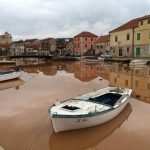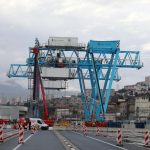On Vis, one of the most distant Croatian islands, throughout history fishing was the most important way to make a living for the people on the island.
And fishermen from Komiža, a port on the western side of the island, had a special fishing sailboat created, with features that they needed to support their customs and practices. The sailboat is called falkuša (pronounced: [ˈfalkuʃa]), it is a subtype of a traditional Dalmatian fishing sailboat gajeta, so often it is called “gajeta falkuša”. The falkuša boats have been around since at least (although there are hints that similar shape and features have existed for longer) the 16th century, and the last of the “original” falkušas, used exclusively for fishing, sank during a storm in 1986. Her remains with complete original equipment can be seen in Komiža’s fishermen museum, which is certainly worth a visit for anyone who has admiration for the sea.
The characteristics of falkuša are quite clearly defined: it is a slender wooden boat, 8 – 9.5 meters long and around 3 meters wine, with quite sharp fore and aft of the vessel. One of its main characteristics was its ability to withstand the journey from Vis to Palagruža, a small island more than half way across the Adriatic, where Komiža fishermen regularly went to catch pilchard. To be able to do that, falkuša was fitted with the so-called “falks” (and that’s exactly where the name comes from, if you’ve been wondering), removable planks that could be fitted when needed on the sides of the vessel to increase the height of the sides by as much as half a meter. The increased height made it possible to sail on the open sea between Komiža and Palagruža, and even further than that, as historic records show that Komiža fishermen used falkuša to get to Malta!
Falkuša usually had a crew of five men, 4 oars and a very large lateen sail, mounted on a mast usually as high as the ship was long. Lateen sail is a triangular sail mounted at an angle on the mast, and oriented in the fore-to-aft direction. On falkuša, the lateen is at a larger angle than on most Dalmatian gajeta boats, which makes it resemble north-African feluccas. The shape and size of the boat and the sails made falkuša a rather fast vessel, as it was able to achieve the speeds of around 10 knots, either under sail or with oars. The speed was quite important for the fisherman, as their fishing trips to over 40 nautical miles distant Palagruža lasted around 3 weeks, and getting there and back fast and safe was a major concern. The average falkuša could carry up to 8 tonnes of cargo, along with the crew – usually the salted fish on return from Palagruža.
The 42 nautical mile trip to Palagruža was the key route for 50-100 falkuša boats fishing in those seas. On Palagruža, small provisional houses were built on the beaches, which were used to store what was caught and some non-critical fishing equipment during the days that were spent fishing. In order to determine which of the crews would get the best positions on Palagruža, Komiža fishermen decided to – race! So, in 1593 the first “Komiška regata” (Rota Palaguzona in Italian) annual race was held (the first one was actually to the island of Hvar, but later they were held between Komiža and Palagruža), and the winners were given the best fishing areas and positions on the beaches for the entire season. The last Komiška regatta was held in 1936, as the advent and availability of ship engines made it obsolete. In the past years, the tradition has been revived, for tourist and historic purposes only, of course, and many recent falkuša replicas participate in it in June of each year, along with other vessels. One of the first modern replicas of falkuša was built and exhibited at EXPO ’98 World Exhibition in Lisbon, as an example of Croatian nautical tradition. In Komiža these days you can see a few of those replicas, some fitted with the engines, but otherwise built to be as similar to the historic vessels as possible.










